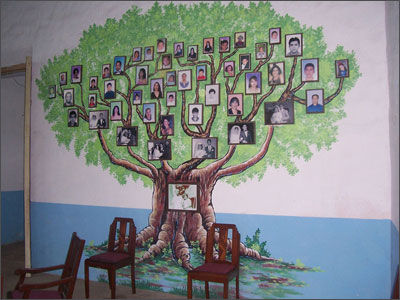To define the contents of every issue of the magazine, the first step was to contact the local historian of each municipality, who was in charge to write an historical profile of each community and helped us to locate the people that kept the old photos, the oldest families, the most popular characters and the most important places.
|
Interviewing
people to collect data for the magazine. 2005 |
After making contact with them, they gave us information concerning other families that might have more photographs. The main challenge was to convince people to provide us with the pictures so we could digitalize them. We had to explain their documentary value and sometimes we offered them to clean them and give them a digital back up when we returned to them.
The information of each image was obtained by interviewing the elders of the community, who provided very important data.
|
Juan
Aguilar Del Rivero of Palizada providing information of his pictures.
2005 |
There is no other similar project in Campeche, except for the project of Mr. Humberto Caldera, who only dealt with his hometown, Ciudad del Carmen. Therefore, Blanco y Negro is one of the most significant projects for the salvage and dissemination of ancient photographs.
We are very satisfied by our accomplishments. The material contained in every magazine has become in one of the most important sources of historical knowledge of these communities, of how their inhabitants were, what were their social, cultural and religious activities, but also to remember their forgotten traditions, and in many occasions to reflect upon the changes suffered by their environment, the old houses transformed into offices or businesses, the disappeared parks and streets turned into avenues.
The images presented by Blanco y Negro present us with the costumes of yore, their garments, hairdos and moustache styles that mark the different epochs and social status. Blanco y Negro is already an effective instrument to help future historians and social anthropologists in their research.
We have salvaged around 3000 photographs that were doomed to oblivion. Most of them are in black and white. Our goal in making an historical family photo archive is to identify the person in the picture, place, date, technique and, if possible the name of the photographer, including the pictures that did not make it to the magazines due to their poor quality.
|
Seeing
the photos of Mrs. Maria Antonia Reyna Ibarra, member of one of
the families from Coahuila that colonized Candelaria in 1961. 2005 |
The main goal of Blanco y Negro is to rescue those images that captured a precise moment, an event, a funeral, festivities or any other subject that the photographer, either amateur or professional, deemed worthy of being recorded and ended up in a family album.
|
Click to enlarge |
To wrap up, in all eleven municipalities of Campeche we have had the satisfaction of obtaining a great variety of pictures that belonged to families of every social level, which evoke beautiful moments of the past of great artistic value.
Marilyn Domínguez Turriza
marilyndominguez@hotmail.com



